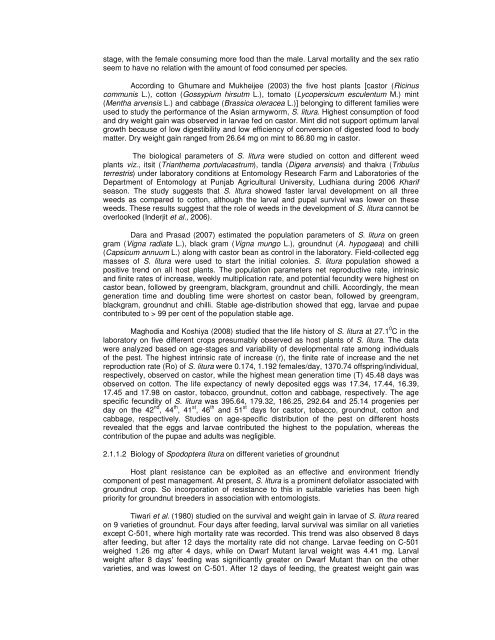screening elite genotypes and ipm of defoliators in groundnut
screening elite genotypes and ipm of defoliators in groundnut
screening elite genotypes and ipm of defoliators in groundnut
You also want an ePaper? Increase the reach of your titles
YUMPU automatically turns print PDFs into web optimized ePapers that Google loves.
stage, with the female consum<strong>in</strong>g more food than the male. Larval mortality <strong>and</strong> the sex ratio<br />
seem to have no relation with the amount <strong>of</strong> food consumed per species.<br />
Accord<strong>in</strong>g to Ghumare <strong>and</strong> Mukheijee (2003) the five host plants [castor (Ric<strong>in</strong>us<br />
communis L.), cotton (Gossypium hirsutm L.), tomato (Lycopersicum esculentum M.) m<strong>in</strong>t<br />
(Mentha arvensis L.) <strong>and</strong> cabbage (Brassica oleracea L.)] belong<strong>in</strong>g to different families were<br />
used to study the performance <strong>of</strong> the Asian armyworm, S. litura. Highest consumption <strong>of</strong> food<br />
<strong>and</strong> dry weight ga<strong>in</strong> was observed <strong>in</strong> larvae fed on castor. M<strong>in</strong>t did not support optimum larval<br />
growth because <strong>of</strong> low digestibility <strong>and</strong> low efficiency <strong>of</strong> conversion <strong>of</strong> digested food to body<br />
matter. Dry weight ga<strong>in</strong> ranged from 26.64 mg on m<strong>in</strong>t to 86.80 mg <strong>in</strong> castor.<br />
The biological parameters <strong>of</strong> S. litura were studied on cotton <strong>and</strong> different weed<br />
plants viz., itsit (Trianthema portulacastrum), t<strong>and</strong>la (Digera arvensis) <strong>and</strong> thakra (Tribulus<br />
terrestris) under laboratory conditions at Entomology Research Farm <strong>and</strong> Laboratories <strong>of</strong> the<br />
Department <strong>of</strong> Entomology at Punjab Agricultural University, Ludhiana dur<strong>in</strong>g 2006 Kharif<br />
season. The study suggests that S. litura showed faster larval development on all three<br />
weeds as compared to cotton, although the larval <strong>and</strong> pupal survival was lower on these<br />
weeds. These results suggest that the role <strong>of</strong> weeds <strong>in</strong> the development <strong>of</strong> S. litura cannot be<br />
overlooked (Inderjit et al., 2006).<br />
Dara <strong>and</strong> Prasad (2007) estimated the population parameters <strong>of</strong> S. litura on green<br />
gram (Vigna radiate L.), black gram (Vigna mungo L.), <strong>groundnut</strong> (A. hypogaea) <strong>and</strong> chilli<br />
(Capsicum annuum L.) along with castor bean as control <strong>in</strong> the laboratory. Field-collected egg<br />
masses <strong>of</strong> S. litura were used to start the <strong>in</strong>itial colonies. S. litura population showed a<br />
positive trend on all host plants. The population parameters net reproductive rate, <strong>in</strong>tr<strong>in</strong>sic<br />
<strong>and</strong> f<strong>in</strong>ite rates <strong>of</strong> <strong>in</strong>crease, weekly multiplication rate, <strong>and</strong> potential fecundity were highest on<br />
castor bean, followed by greengram, blackgram, <strong>groundnut</strong> <strong>and</strong> chilli. Accord<strong>in</strong>gly, the mean<br />
generation time <strong>and</strong> doubl<strong>in</strong>g time were shortest on castor bean, followed by greengram,<br />
blackgram, <strong>groundnut</strong> <strong>and</strong> chilli. Stable age-distribution showed that egg, larvae <strong>and</strong> pupae<br />
contributed to > 99 per cent <strong>of</strong> the population stable age.<br />
Maghodia <strong>and</strong> Koshiya (2008) studied that the life history <strong>of</strong> S. litura at 27.1 0 C <strong>in</strong> the<br />
laboratory on five different crops presumably observed as host plants <strong>of</strong> S. litura. The data<br />
were analyzed based on age-stages <strong>and</strong> variability <strong>of</strong> developmental rate among <strong>in</strong>dividuals<br />
<strong>of</strong> the pest. The highest <strong>in</strong>tr<strong>in</strong>sic rate <strong>of</strong> <strong>in</strong>crease (r), the f<strong>in</strong>ite rate <strong>of</strong> <strong>in</strong>crease <strong>and</strong> the net<br />
reproduction rate (Ro) <strong>of</strong> S. litura were 0.174, 1.192 females/day, 1370.74 <strong>of</strong>fspr<strong>in</strong>g/<strong>in</strong>dividual,<br />
respectively, observed on castor, while the highest mean generation time (T) 45.48 days was<br />
observed on cotton. The life expectancy <strong>of</strong> newly deposited eggs was 17.34, 17.44, 16.39,<br />
17.45 <strong>and</strong> 17.98 on castor, tobacco, <strong>groundnut</strong>, cotton <strong>and</strong> cabbage, respectively. The age<br />
specific fecundity <strong>of</strong> S. litura was 395.64, 179.32, 186.25, 292.64 <strong>and</strong> 25.14 progenies per<br />
day on the 42 nd , 44 th , 41 st , 46 th <strong>and</strong> 51 st days for castor, tobacco, <strong>groundnut</strong>, cotton <strong>and</strong><br />
cabbage, respectively. Studies on age-specific distribution <strong>of</strong> the pest on different hosts<br />
revealed that the eggs <strong>and</strong> larvae contributed the highest to the population, whereas the<br />
contribution <strong>of</strong> the pupae <strong>and</strong> adults was negligible.<br />
2.1.1.2 Biology <strong>of</strong> Spodoptera litura on different varieties <strong>of</strong> <strong>groundnut</strong><br />
Host plant resistance can be exploited as an effective <strong>and</strong> environment friendly<br />
component <strong>of</strong> pest management. At present, S. litura is a prom<strong>in</strong>ent defoliator associated with<br />
<strong>groundnut</strong> crop. So <strong>in</strong>corporation <strong>of</strong> resistance to this <strong>in</strong> suitable varieties has been high<br />
priority for <strong>groundnut</strong> breeders <strong>in</strong> association with entomologists.<br />
Tiwari et al. (1980) studied on the survival <strong>and</strong> weight ga<strong>in</strong> <strong>in</strong> larvae <strong>of</strong> S. litura reared<br />
on 9 varieties <strong>of</strong> <strong>groundnut</strong>. Four days after feed<strong>in</strong>g, larval survival was similar on all varieties<br />
except C-501, where high mortality rate was recorded. This trend was also observed 8 days<br />
after feed<strong>in</strong>g, but after 12 days the mortality rate did not change. Larvae feed<strong>in</strong>g on C-501<br />
weighed 1.26 mg after 4 days, while on Dwarf Mutant larval weight was 4.41 mg. Larval<br />
weight after 8 days' feed<strong>in</strong>g was significantly greater on Dwarf Mutant than on the other<br />
varieties, <strong>and</strong> was lowest on C-501. After 12 days <strong>of</strong> feed<strong>in</strong>g, the greatest weight ga<strong>in</strong> was
















